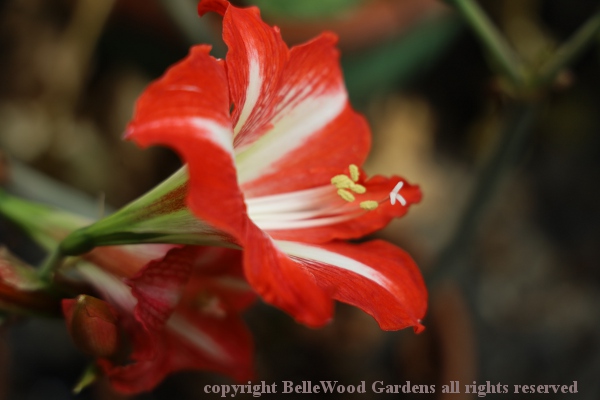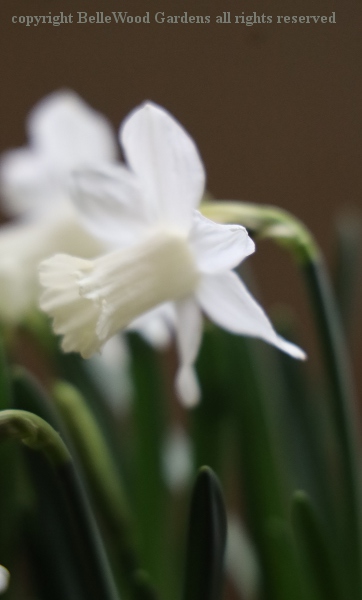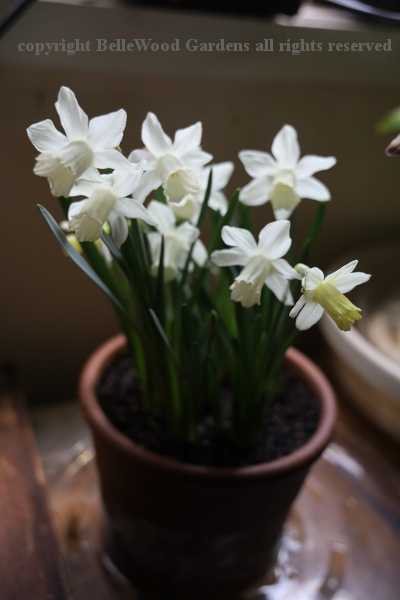| March | ||
| April | May | June |
| July> | August | September |
Friday, 19 September 2025

Not a crocus on steroids, this is Colchicum speciosum. One common name is
the son before the father. People were confused as why there were seed pods
in spring but flowers in autumn. Even if it seems backwards, not in this case.
Thursday, 18 September 2025

Thunberg's bush clover, Lespedeza thunbergii, is welcome for its end of summer flowers.
Monday, 15 September 2025

Oxblood lily, Rhodophiala bifida, spends the summer dry in my greenhouse, then quickly erupts
into bloom in less than a fortnight when brought outdoors and well watered, by me or by rain.
Saturday, 6 September 2025

A bigeneric hybrid, ×Amarcrinum, is a cross between Crinum and Amaryllis belladonna.
Friday, 5 September 2025

Seven sons, Heptacodium miconioides, flowers as summer ends
with these charming panicles of white flowers, popular with bees.
Thursday, 4 September 2025

The summer has turned quite dry. Whereas Sauromatum had earlier developed huge leaves

they are now wilting and collapsing, unable to maintain active growth.

A gentle tug easily separates the leaf's stem end from the tuber's

growing point. Once dug, there are numerous offsets to be seen. Dried off,
brushed free of soil, packed away in peat moss, then sleep winter away in
the frost-free garage until spring returns and once again it is time to grow.
Saturday, 30 August 2025

With common names of peacock flower, tiger flower, jaguar flower, or shell flower, when
you see Tigridia pavonnia in bloom it is easy to understand why such showy names.
Thursday, 14 August 2025

Another summer flowering bulb, though this one is winter hardy. Common name is
naked lady, because it flowers naked, no leaves. Latin name is Lycoris ×squamigera.
A recent study shows it to be a sterile hybrid between L. sprengeri and L. longituba.

An intense storm yesterday damaged edges of the flower petals.
.
The weather has been hot. Recently there was rain, nearly an inch.

The Japanese fiber banana, Musa basoo, loves it. It grows as I watch.
.
Flowers are lovely but most quickly come and go. Leaves last longer. And there are colorful, other than green leaves.
 .
.
For example, cannas. On the left, Canna 'Tropicanna' and on the right, C. 'Bengal Tiger' aka 'Pretoria'.

And this somber beauty, C. flaccida 'Purpurea', with narrow, dark purple leaves.
Thursday, 7 August 2025

Aptly given the common name of cardinal flower, Lobelia cardinalis, is as vivid as a male cardinal.

The flower stalk of Crinum ×powellii emerges to the side of and not from the center of the leaves
as, say, daffodils. Very large bulb, massive leaves, shoved in a corner of the greenhouse for winter.
Saturday, 2 August 2025

Done flowering, the stalks of Eucomis pallidiflora pole-evansii, still attractive, have toppled over.

Rain lily, flower of the west wind, Zephyranthes candida enjoys growing with wet feet.
Thursday, 24 July 2025

Bottlebrush buckeye, Aesculus parviflora, is an excellent shrub for somewhat shady places.
I raised this one from seed. Pleasant foliage, delightfully late time of bloom . It does sucker.

I am concerned this summer. Not with the shrub itself but at the lack of butterflies.
Previously there would have numerous black and tiger swallowtails. This year - none.
.
Most of the appreciation for hydrangeas seems to be for billowy blue or pink mopheads.
They may be fine for formal gardens. That's not the style here at my BelleWood Gardens.

Hydrangea paniculata is much more suitable for my woodland. No pruning needed either.

Although I will say that the Japanese fiber banana, Musa basjoo, really does love hot humid weather.
Sunday, 13 July 2025

Crocosmia 'Lucifer'is the hardiest native of these bulbs (corms, actually) from the grasslands
of southern and eastern Africa. The attractive, fiery bright red flowers are good for cutting.
Sunday, 15 June 2025

I forget how long I have had this Eucomis pole-evansii. In all that time the original bulb
has become two. But that's all. It spends the winter dry and dormant in the basement. At some
unknown signal (I don't water it) up come the leaves. Necessary to get it up into light ASAP.
Monday, 9 June 2025

Yellow foxglove, Digitalis lutea, has been spreading around by self seeding. Let it.
While each plant lives for just a few years it does reseed. Deer and other pests do not eat it.

Wednesday, 4 June 2025

A charming red amaryllis is in flower. I raised it from OP (open pollinated) seed. Pretty.
I find these more modest-in-size flowers have a certain appeal that the huge ones do not.
Monday, 26 May 2025
You know acanthus, those leaves decorating the top of columns
in Greek and Roman architectural tradition, as eary as 450-420 BC

image copyright free from Wiki Commons
Any column in my garden is more of a plinth, supporting a pot.

But I do have an actual acanthus, Acanthus mollis 'Tasmanian Angel'.
Friday, 18 May 2025

Why BelleWood? Well, there are bells in the garden, such as these two small Arcosanti bells.>/p>

I grow Oxalis regnellii var. triangularis for its intense purple-with-magenta-splotch leaves.

Columbines reseed here and there. As I only have this purple with white, all the seedlings come "true.'

Ajuga reptans does spread out where it will. But its spring flowers are a lovely rich blue.

Properly, the name for this shrub is Chaenomeles ×superba 'Cameo'
but it may be named Cydonia. Both are quince. Chaenomeles is the
ornamental shrub. Cydonia is the tree whose fruit is used for preserves.
Sunday, 6 May 2025

Early peonies. This is Paeonia 'Early Scout', a hybrid with fern leaf peony ancestry.

'Illini Warrior' is another early single peony with petals
of rich deep color and bright golden stamens at center.

Rhododendron yakusimanum showing color. Deep pink buds open to apple blossom pale pink.
Friday, 4 May 2025

I ininheritedherited this Rhododendron yakusimanum when my friend John Osborne died. That was
back in Connecticut. Of course when we moved to New Jersey it was one of the plants that
moved with us. Safe from deer - there's a fuzzy indumentum on the underside of the leaves.
Thursday, 24 April 2025

My most reliable amaryllis. Hippeastrum 'Baby Star' is flowering in the greenhouse.


Several cultivars of Narcissus poeticus are flowering beautifully along the path to the Forest Deck.

The bulbs were a gift from a friend when we moved here back in 1995. Very reliable.

Pristine white petals, very short cup green at the throat, yellow, and a thread of red.
Saturday, 12 April 2025

Daffodil season. 'Dutch Master' at the bottom of the driveway. This cultivar has replaced
'King Alfred' as it is preferred for its hardiness, larger flower size, and overall vigor.

Continuing up the driveway towards my tool shed you'll find 'Ice Follies' White petals
and a cup that opens yellow and then fades to white. Another favorite, reliable cultivar.

Several Magnolia stellata, flowering down in the woods, across the seasonal brook.

I didn't thing last winter was that severe. Apparently I'm wrong. Both the short bamboo

and the tall running kind have completely browned off. I see the same wherever I drive.
Monday, 31 March 2025
Over time I planted 6 or 7 star magnolias, Magnolia stellata, here at BelleWood Gardens.
They are the familiar white flowered kind. I like them, in part, because their straplike petals
seem less subject to frost damage than the much larger M. soulangeana that collapse and fall

In view from the front door is a cultivar with lovely pink flowers, M. stellata 'Rosea'.

Well named, don't you think.
Thursday, 20 March 2025
I was not sure where to put this. Certainly it could be in Flowers Around Town as these early little bulbs

snowdrops and winter aconites, have shown their way up above last autumn's fallen leaves

and here they are across the road from BelleWood Gardens. But I do know that's where they came from.
How did they get here? Floods washing them across the road? Gardening squirrels? What do you think?
Wednesday, 19 March 2025
It's the little bulbs that bring the first flowers. They seem quite happy here, multiplying nicely.
Winter aconites, Eranthis hyemalis, are frustrating to begin, then settle in and become very happy.

They grow from a small, even call it a tiny tuber. Which do not appreciate drying out for shipment.
Fortunately their price is as minute as their size. So plant as many as you are comfortable buying,
soak in damp peat moss overnight, then plant. If 20% appear next spring you can rejoice. Because
they'll flower, seed, reproduce, and in only a few years the few bright flowers become very many.
Snowdrops are perhaps the most iconic of the little end-of-winter flowering bulbs.
While similar overall, there are several different species, there are named cultivars.

Galanthus woronowii differs from the common snowdrop, G. nivalis, in that it has bright green leaves.

Galanthus 'Virid Apice' is distinguished with a green marking on its three outer petals.

Galanthus 'Hill Poë' is a sturdy double snowdrop discovered in an Irish garden in 1911.

Not a snowdrop but rather a snowflake, Leucojum vernum, for vernal meaning
in, or appropriate to spring. Looks rather like a bell, or a starched white petticoat.

A crocus. Not positive if it is Crocus vernus or perhaps a deep colored cultivar of C. tommasinianus

The dainty little two leaved scilla, Scilla bifolia with its raceme of starry blue flowers.
Narcissus (or do you think of them as daffodils) provide a forecast of spring.

Narcissus 'Rijnveld's Early Sensation' from circa 1943, is the earliest of trumpet daffodils to flower

by a good two weeks. Absolutely cold hardy, it stands up to surprise snowfalls. Skullduggery
in its naming. Apparently (or so the story goes) it was originally bred by F. Herbert Chapman
in England sometime before 1943, but only registered in 1956 by F. Rijnveld & Sons of Holland.

I'm not sure who this daffodil might be. My records have it as 'Mustard Seed' but it looks
nothing like the online information for that name. After some research I now believe it is
Narcissus minor 'Cedric Morris', which does make sense as it is also very early into bloom.
Now onward from bulbs with their underground stored food reserves to perennials.

That of course brings BelleWood into bloom with hellebores. Here, my favorite deep purple
of Helleborus Early Purple Group. What's not to love - they grow in woodland shade, are
pest proof, even by deer that believe my garden is a salad bar, and display their lovely flowers

unharmed by freezing weather that nights might bring. This year there was massive leaf browning.

Hellebores do, by the way, offer their flowers for a fresh from the garden bouquet.
Tuesday, 11 March 2025

Last November I presented a talk on "Little Bulbs for Rock and Woodland Gardens" to the Delaware Valley NARGS (that's North American Rock Garden Society) chapter in Pennsylvania. They are a very active group. All who attended were given a little bag with some spring flowering bulbs. I came home with two gift bags of Narcissus 'Ice Baby' bulbs. (My friend Bill who came with me graciously gave me his.) Rather than plant outdoors I decided to pot them up.
Now the nice thing about daffodils is that if you use a standard flower pot (as tall as it is wide) and plant in two layers they'll all grow and flower at the same above-soil height. It's like this: Fill pot 1/3 with potting mix. Set bulbs at north, east, south, west. Fill pot with 1/3 more potting mix and set bulbs at northeast, southeast, southwest, northwest. And one or two bulbs in the center. Then finish filling pot with potting mix.
I watered the pot and set it in our unheated garage to root and grow. As you can see, the results delight me.

And meanwhile, in the greenhouse

where it is warmer than the garage! - clivia is in flower.
Saturday, 8 March 2025

Springtime delights as time changes and galanthus flower in the garden.